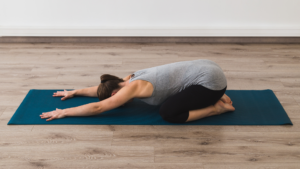Today, we’re going to dive into the world of chiropractic stretches and explore their importance in promoting flexibility, relieving pain, and supporting overall spinal health. Whether you’re dealing with lower back pain, upper back discomfort, or neck stiffness, incorporating specific stretches into your routine can make a significant difference. Join us as we guide you through some stretches recommended by our chiropractors, provide insights on stretching safety at home, and offer advice on how often to stretch for optimal results.
Why is Stretching Important?
Stretching is more than just a warm-up or cool-down activity—it’s a vital component of maintaining a healthy and functional musculoskeletal system. Regular stretching offers numerous benefits that go beyond flexibility enhancement. Here are some reasons why stretching should be an essential part of your routine:
Improve flexibility with chiropractic stretches
Stretching helps increase your range of motion by lengthening and elongating muscles and tendons. This improved flexibility allows you to move more freely and perform daily activities with ease.
Enhance muscle performance with chiropractic stretches
Stretching before physical activity prepares your muscles for action by increasing blood flow and oxygen delivery. This, in turn, can enhance muscle performance and reduce the risk of injuries.
Reduce muscle tension with chiropractic stretches
Prolonged periods of inactivity or poor posture can lead to muscle tension and tightness. Regular stretching helps alleviate muscle tension, promoting relaxation and reducing the likelihood of muscle imbalances.
Improve Posture with chiropractic stretches
Stretching can help correct postural imbalances by targeting specific muscle groups. By releasing tension and lengthening tight muscles, stretching supports proper alignment and posture.
Pain relief with chiropractic stretches
Many individuals experience pain or discomfort due to muscle imbalances, tightness, or poor posture. Stretching can help alleviate these issues by promoting muscle relaxation, reducing stress on joints, and relieving pain.
Is stretching safe to do at home?
Stretching is generally safe and can be performed at home, provided that you follow proper techniques and guidelines. However, it’s essential to be cautious and listen to your body to avoid any potential injuries. Here are some tips to ensure safe stretching at home:
Stretching tip #1: Warm-up before stretching

Prior to stretching, engage in a light warm-up activity such as walking or gentle movements to increase blood flow to the muscles and prepare them for stretching.
Stretching tip #2: Start your stretches gradually
Begin with gentle stretches and gradually increase the intensity or duration over time. Avoid pushing yourself too hard, as this can lead to muscle strains or sprains.
Stretching tip #3: Focus on proper form
Pay attention to your technique and ensure that you’re performing each stretch correctly. Incorrect form can increase the risk of injury and diminish the effectiveness of the stretch.
Stretching tip #4: Avoid bouncing or jerking movements when stretching

When stretching, maintain a smooth and steady motion. Avoid bouncing or jerking, as this can strain the muscles and potentially lead to injuries.
Stretching tip #5: Listen to your body
Each person’s flexibility and limitations are unique. Respect your body’s signals and avoid overstretching or pushing through pain. Stretch to a comfortable point of tension, not pain.
If you have any pre-existing medical conditions or concerns about stretching, it’s advisable to consult with a chiropractor before starting a stretching routine.
Here at Chiropractic Singapore, we provide comprehensive spinal check-ups by our experienced chiropractors at any of our 4 conveniently located centres.
Stretches recommended by our experienced chiropractors
Now that we’ve discussed the importance of stretching and its safety, let’s explore some stretches recommended by our chiropractors. These stretches target different areas of the spine and can help alleviate specific types of pain or discomfort. Remember to perform these stretches with proper form and technique for maximum benefit.
Stretches for lower back pain
Lower back pain is a common issue that many individuals face. Here are three stretches that can help relieve tension and promote flexibility in the lower back:

- Child’s pose: Start by kneeling on the floor with your knees hip-width apart and your toes touching. Lower your hips towards your heels, extending your arms in front of you. Relax your forehead on the floor and breathe deeply, feeling the stretch in your lower back and hips. Hold this pose for 30 seconds to one minute.

- Knee-to-chest stretch: Lie on your back with your knees bent and feet flat on the floor. Bring one knee towards your chest, grasping it with both hands. Gently pull the knee closer to your chest until you feel a stretch in your lower back. Hold for 20-30 seconds, then switch legs.


- Cat-camel stretch: Begin on all fours with your hands directly under your shoulders and your knees under your hips. Start by arching your back upward, dropping your head down and tucking your chin towards your chest (cat position). Hold for a few seconds, then slowly reverse the movement. Drop your belly towards the floor, lift your head and chest, and look upward (camel position). Repeat this sequence for 8-10 repetitions, focusing on the gentle movement of your spine.
Stretches for upper back pain

If you’re experiencing discomfort in your upper back, these stretches can help alleviate tension and promote mobility:
- Shoulder Blade Squeeze: Sit or stand with your back straight. Gently squeeze your shoulder blades together, imagining you’re trying to hold a pencil between them. Hold for 5-10 seconds, release, and repeat for 10 repetitions.
- Upper Back Extension: Stand with your feet shoulder-width apart. Place your hands on your lower back, fingers pointing downward. Slowly arch your upper back, leaning back slightly. Hold for 10-15 seconds and return to the starting position.
- Thoracic Rotation Stretch: Sit on the edge of a chair with your feet flat on the floor. Place one hand behind your head, with your elbow pointing out to the side. Slowly rotate your torso to the opposite side, using your free hand to provide gentle resistance. Hold the stretch for 20-30 seconds, feeling the rotation in your upper back. Repeat on the other side.
Stretches for neck pain

Neck pain can be debilitating, but these stretches can provide relief and help improve flexibility in the neck area:
- Neck Side Bend: Sit or stand with your back straight. Tilt your head towards one shoulder, gently stretching the opposite side of your neck. Hold for 20-30 seconds, then repeat on the other side.
- Neck Rotation: Sit or stand with your back straight. Slowly turn your head to one side, looking over your shoulder. Hold for 20-30 seconds, then repeat on the other side.
Remember to perform these stretches in a controlled and comfortable manner, avoiding any sudden or jerky movements.
However if you face any discomfort during or after stretching, you may book a comprehensive spinal check-up here at any of our 4 conveniently located centres to receive a professional evaluation & advice from our experienced chiropractors.
How often should I stretch?
The frequency of stretching depends on various factors, including your overall health, fitness level, and specific goals. As a general guideline, incorporating stretching exercises into your daily routine is beneficial. However, if you’re just starting, you can aim for at least two to three stretching sessions per week.
To maintain flexibility and maximise the benefits, consider the following recommendations:
Pre-exercise stretching
Perform a brief stretching routine before engaging in physical activities or workouts. This helps warm up the muscles, improves flexibility, and prepares your body for the upcoming exercise.
Post-exercise stretching
After completing your workout or physical activity, include a longer stretching routine to cool down your muscles, aid in recovery, and promote flexibility.
Take regular breaks by stretching
If you have a sedentary job or spend long hours sitting, take regular breaks throughout the day to stretch and relieve tension in your muscles. Aim for a short stretching routine every hour or two.
Listen to your body
Pay attention to your body’s needs and adjust your stretching routine accordingly. If you’re experiencing muscle tightness or stiffness, incorporate additional stretching sessions to alleviate discomfort.
Remember, consistency is key when it comes to stretching. Make it a habit, and gradually increase the duration or intensity of your stretches as your body becomes more flexible.
Incorporate these stretches recommended by our chiropractors to alleviate pain and improve your quality of life!
Stretching is a powerful tool for promoting flexibility, relieving pain, and supporting overall spinal health. By incorporating recommended stretches into your routine, you can enhance your flexibility, alleviate pain and discomfort, and improve your quality of life. Remember to prioritise safety, listen to your body, and book a consultation with our chiropractors if you have any concerns or pre-existing medical conditions.
Alternatively, we hope this blog post has provided you with valuable insights into the world of chiropractic stretches. If you’re experiencing persistent pain or discomfort, don’t hesitate to reach out to our team of chiropractors for a comprehensive evaluation and personalised care plan. Start incorporating stretches into your daily routine and experience the benefits firsthand. Your spine is the backbone of your overall well-being, so invest in its health and enjoy a life of comfort and vitality.








